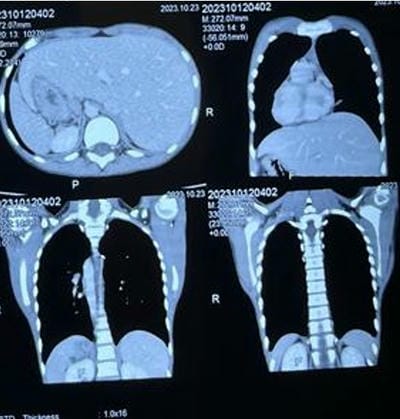Kartagener's syndrome with Dextrocardia - A case report
Kushwaha A1*, Sinwal A2, Singh I3, Upadhayay K4, Bhardwaj M5, Baby S6
DOI:https://doi.org/10.17511/ijmrr.2024.i02.04
1* Aman Kushwaha, Pharm D, Pharmaceutical Sciences, Jaipur National University, Jaipur, Rajasthan, India.
2 Aashutosh Sinwal, Pharm D, Pharmaceutical Sciences, Jaipur National University, Jaipur, Rajasthan, India.
3 Ishu Singh, Pharm D, Pharmaceutical Sciences, Jaipur National University, Jaipur, Rajasthan, India.
4 Kalpana Upadhayay, Pharm D, Pharmaceutical Sciences, Jaipur National University, Jaipur, Rajasthan, India.
5 Mudit Bhardwaj, Pharm D, Pharmaceutical Sciences, Jaipur National University, Jaipur, Rajasthan, India.
6 Smrithimol Baby, Pharm D, Pharmaceutical Sciences, Jaipur National University, Jaipur, Rajasthan, India.
One rare variant of immotile cilia syndrome is known as Kartagener's syndrome. The sinus, eustachian tube, middle ear, and respiratory tract cilia are all impacted by Kartagener's syndrome. These cilia's inability or improper movement causes persistent issues with the ear and sinuses. Some individuals with dextrocardia may not experience any symptoms, while others may have heart-related issues or other associated health problems. Diagnosis typically involves imaging studies such as X-rays, echocardiograms, or CT scans to visualize the position of the heart and other organs. Treatment depends on the presence of any associated heart defects or health issues. In many cases, individuals with dextrocardia can lead normal, healthy lives with proper medical management. Close collaboration between patients and healthcare providers is essential for individuals with dextrocardia to track their heart health and general wellness. If needed, regular check-ups and appropriate medical interventions can help manage any potential complications associated with this condition. Individuals with dextrocardia need to work closely with healthcare professionals to monitor their heart health and overall well-being. If needed, regular check-ups and appropriate medical interventions can help manage any potential complications associated with this condition.
Keywords: Dextrocardia, Echocardiograms, Eustachian tubes
| Corresponding Author | How to Cite this Article | To Browse |
|---|---|---|
| , Pharm D, Pharmaceutical Sciences, Jaipur National University, Jaipur, Rajasthan, India. Email: |
Kushwaha A, Sinwal A, Singh I, Upadhayay K, Bhardwaj M, Baby S, Kartagener's syndrome with Dextrocardia - A case report. Int J Med Res Rev. 2024;12(2):52-56. Available From https://ijmrr.medresearch.in/index.php/ijmrr/article/view/1467 |


 ©
© 